Prior to the entrance of the US into WWI, the US Army was a small, professional force. In 1916 the Army consisted of only 140,000 men. When the US declared war on Germany, the Army strength had been expanded around 200,000 men. In the next couple of years, the US Armed Forces would expand exponentially. Ultimately, 4 million men would be drafted into the service. In July 1918, there were over a million US troops in France.
With all of this expansion came some problems. One of these was, “How are we going to arm all of these men?” We have come a long way in the world of manufacturing since 1917. During one of the last “panics”, it has been said that enough weapons and ammunition were sold to outfit the entire Chinese and Indian armies. And then a few months later, these items were again readily available. This would’ve been completely unthinkable in 1917. Back then, there obviously were no 3D printers or CNC machines. Now we take some of this for granted, and it is hard to imagine the enormity of the task they were facing at the time. This situation led to some unconventional solutions.
The standard cartridges of the US army were the .30-06 Springfield, for the 1903 Springfield rifle and the few machine guns it possessed, and the .45 ACP, which was obviously used in the model 1911 pistol. It became apparent very quickly that the government arsenals were not going to be able to produce enough weapons to equip the rapidly expanding American Expeditionary Force(AEF). At that time, some commercial firearms manufacturers were making arms for some of the Allied nations already involved in the war. It was fairly quickly discovered that some of these weapons would lend themselves to be chambered in the US standard calibers. Some examples of this would be the 1917 “Enfield” rifle, which was essentially a rebarrelled Pattern 14’, and the Lewis gun. Other commercially made firearms were simply “militarized” by adding some features or parts and pressed into service, such as the Winchester 1897 shotgun.
Handguns presented something of a problem, however. The US Military was actually rather forward thinking when it came to sidearms. While most of the other armies engaged in WWI were still using revolvers of one sort of another, the US was issuing an auto pistol. Most armies of that time looked at sidearms more or less as a badge of rank, whereas the US looked at them as real combat weapons. As such, there simply wasn’t a suitable pistol design in production that could be adapted as auto pistols were a relatively new innovation. And there was no way that 1911s were going to be able to be produced fast enough to meet the needs of the war department, even with some additional companies producing them. There were some larger framed double action revolvers in production, chambered in .45 calibers even. But the .45 ACP was a rimless cartridge which meant that the extractors in these guns wouldn’t be able to extract the cases. And the War Department did not want to have to ship another caliber over to Europe to supply the AEF.
The Colt New Service was one of the double action revolvers in production at that time. It was quite clearly intended for military use, though Colt did sell some commercially. Colt had already sold some to the Government, in the form of the Model 1909, in prior years. It was chambered in .45 Colt in US service. After the outbreak of The Great War, the British were woefully short of handguns as well and contracted Colt to produce New Service revolvers chambered in .445 Eley (Webley).
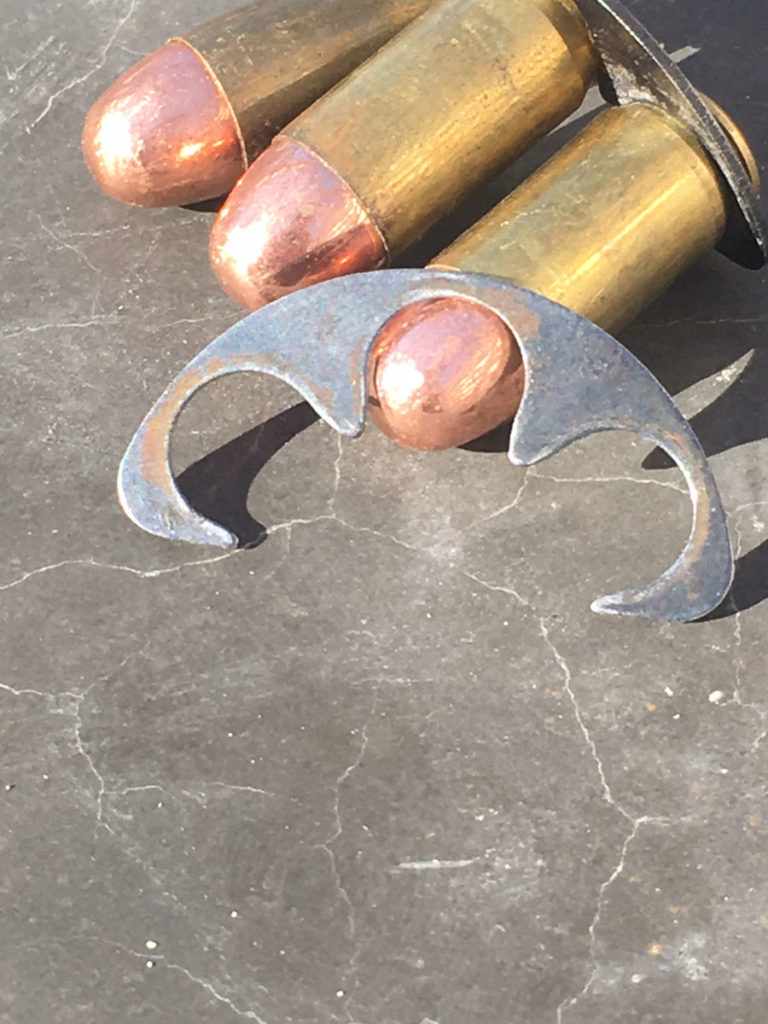 So, Smith and Wesson came up with an idea of how to make revolvers capable of using the rimless .45 Auto in revolvers. The idea was a rather simple one: stamped metal clips. The rounds would be inserted in these clips. Then the extractors of the Colt New Service Revolvers (as well as the comparable S&W model) would be able to grab the clips and extract the empty casings. It still required some slight modifications to the revolvers themselves, mainly in the cylinders would have to be machined to allow clearance for the clips. The added bonus would be that reloading would be significantly faster than loading cartridges singly.
So, Smith and Wesson came up with an idea of how to make revolvers capable of using the rimless .45 Auto in revolvers. The idea was a rather simple one: stamped metal clips. The rounds would be inserted in these clips. Then the extractors of the Colt New Service Revolvers (as well as the comparable S&W model) would be able to grab the clips and extract the empty casings. It still required some slight modifications to the revolvers themselves, mainly in the cylinders would have to be machined to allow clearance for the clips. The added bonus would be that reloading would be significantly faster than loading cartridges singly.
The first converted Colt models were .45 Colts that had the cylinders bored out to accept the .45 ACP, headspacing on the rim. The problem with the first revolvers converted was that if clips were not available, the rounds would simply fall all the way through the cylinder. Even if it were possible to get them to stay long enough to close the cylinder, there wouldn’t be anything to keep the cartridge in place to allow the firing pin to hit the primer. The War Department was not particularly happy with this idea. So all of the rest of the 1917 model revolvers had their cylinders actually chambered in .45 ACP as intended, headspacing on the case mouth. This allowed the .45 ACP cartridges to be used without clips in an emergency, though the cases would have to be extracted by some means other than the extractor.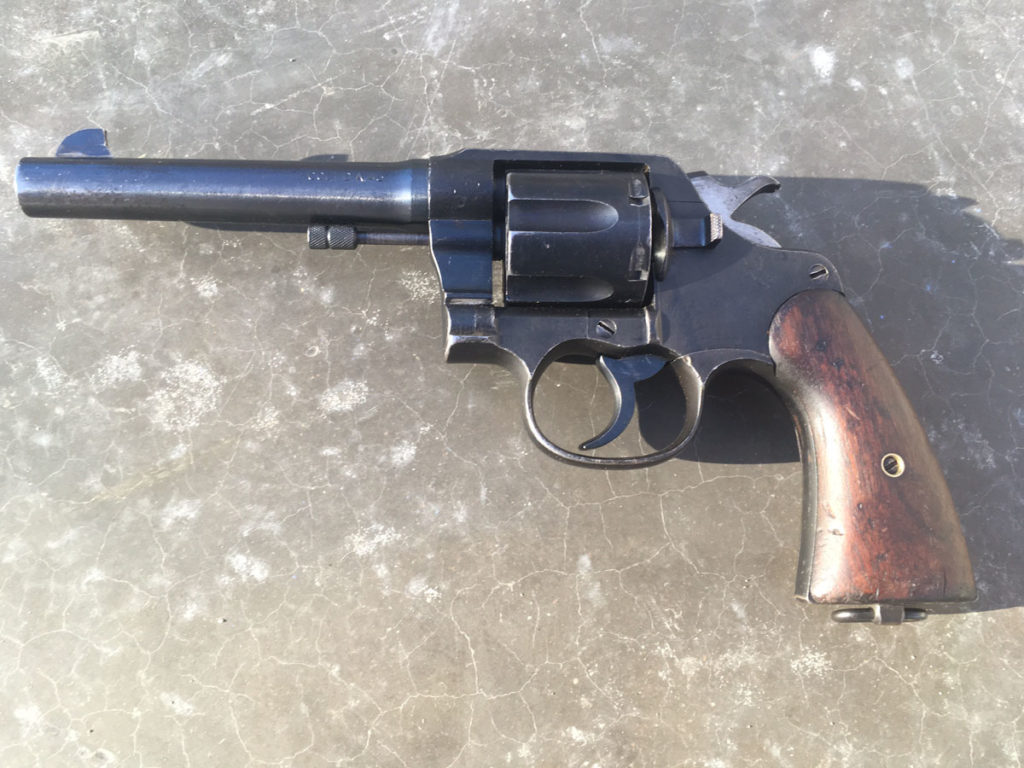
Around 150,000 Colt Model 1917s were obtained by the Armed Forces in WWI. They were issued right alongside 1911s and the 1917 revolvers from Smith and Wesson. They did see extensive front line service during the war, and performed well in the nasty environment of trench warfare.
The .45 ACP loading used at the time is the rather familiar 230gr FMJ Round Nose loaded to produce a velocity of around 850 feet per second. The only real difference was in the appearance of the bullets themselves. The bullet jackets were made of a different material than the copper that we have grown accustomed to, and had a silvery appearance. This is only a cosmetic difference and functionally, the ammunition wasn’t much different than the 230gr FMJ ammunition at your local gun shop.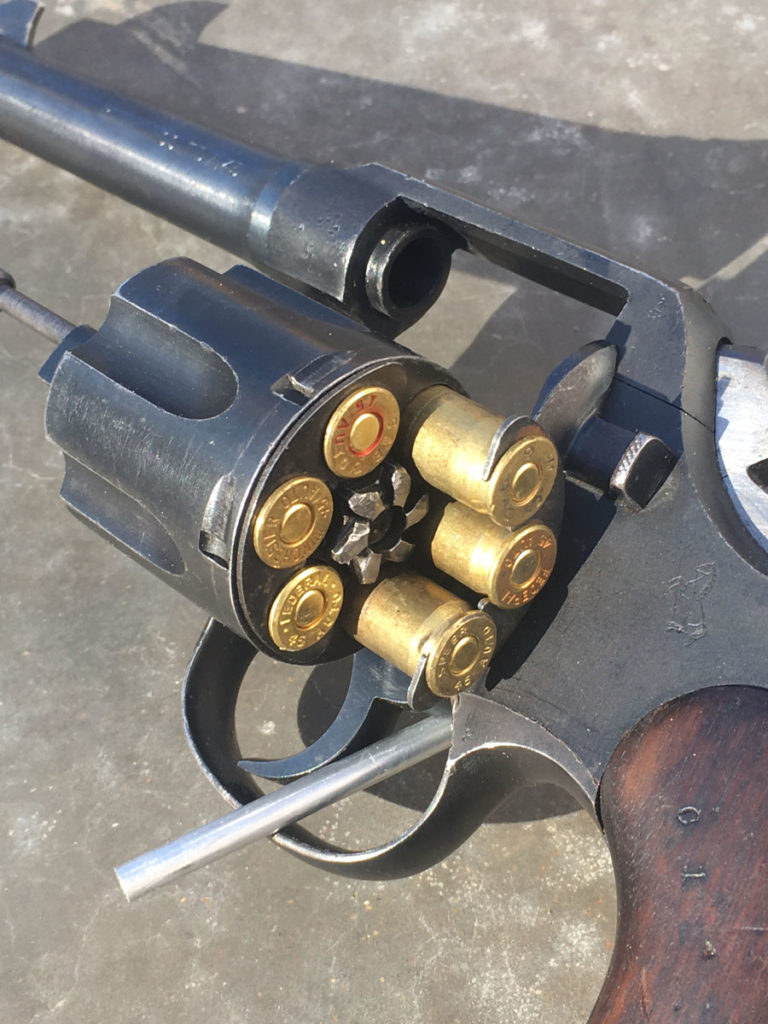
After the First World War, the Model 1917 revolvers were pulled from service and put into storage. When the US became involved in WWII, again the US military was small in size. The demand for weapons far exceeded supply. So the Model 1917s were pulled out of storage and issued again. Some of these revolvers were in pretty rough shape from their last trip to Europe. So they were refurbished before being issued. The early, bored out cylinders were replaced as were other worn out parts. These guns were then parkerized, as most US weapons were at that time. This is one of the easiest ways to tell if a 1917 was re-issued in WWII, as the revolvers that were not refurbished would still have the original blued finish. It was intended that the 1917 revolvers be used in second-line service, for MPs and other non-combat roles. However, there were instances of Infantryman using them in front-line actions.
The sheet metal clips that made it possible to use rimless .45 ACP cartridges were essentially the first “speedloaders”. They are still in use today and not just with the original 1917 revolvers. Interestingly, there are several different revolvers chambered in several auto pistol cartridges being made today, most of which are intended to use a metal clip. Shooters like Jerry Miculek have set records shooting .45 ACP revolvers, using “moon clips”(as opposed to the “half-moon 3 round clips) to reload, which shows the effectiveness of the concept. Not bad for a “stop-gap” idea.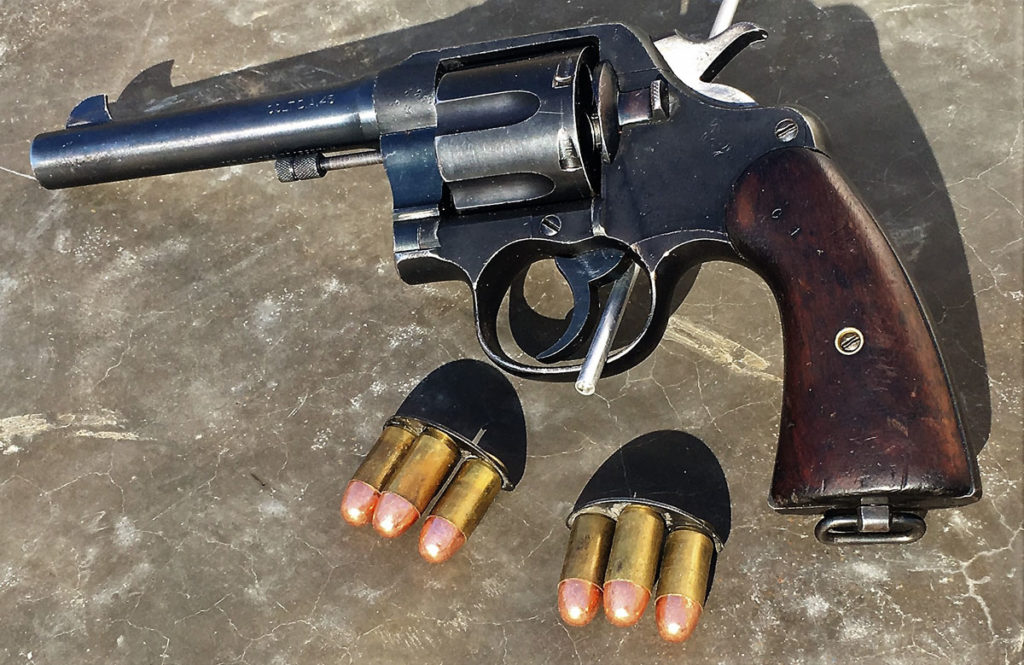
In 1920, a modified case was invented for use in these, the .45 Auto Rim. As the name suggests, it is a .45 ACP with a traditional rim to allow proper extraction of cases without using clips. While this ammunition is not common by any means, both loaded ammo and casings can be found if you prefer not to use clips in your revolver. For reloading, it is possible to use the same components as you would for .45 ACP (aside from the brass of course).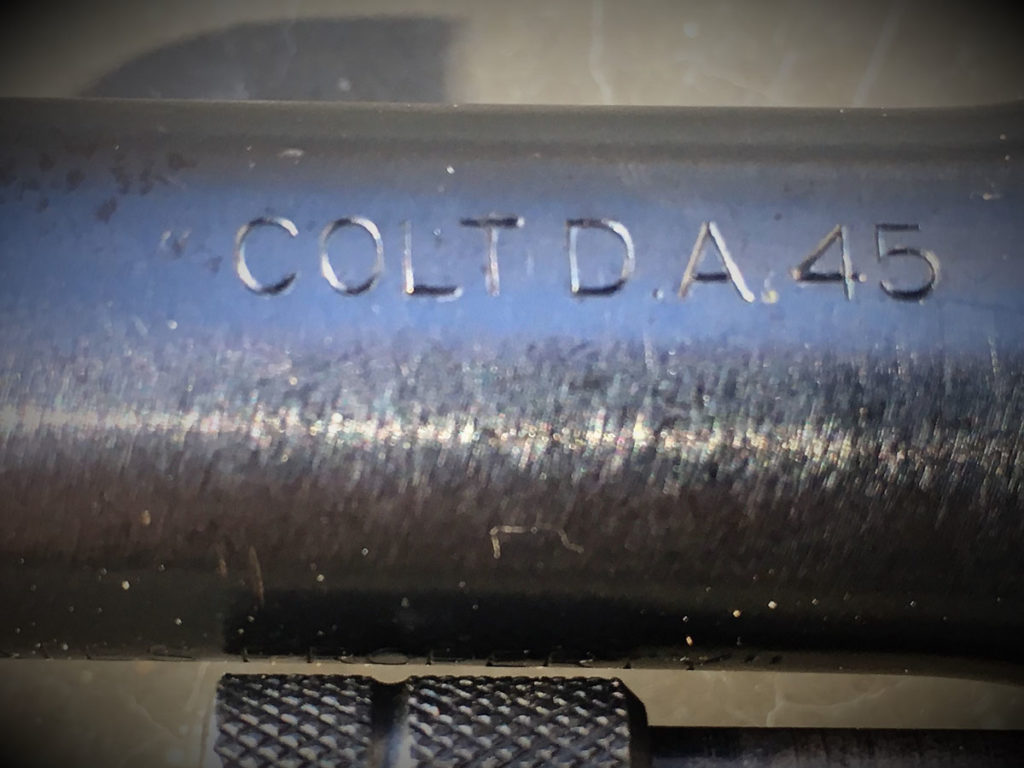
There isn’t any particularly good reason to try and hot rod a firearm that’s 100 years old, even if it is of a strong design. So don’t use +p loads or ammunition. Stick to reasonable loads. The good news here is that there are a bunch of loads and factory ammunition suitable for use in the 1917 revolver. .45 Auto has been with us for a long time, and it doesn’t seem like there has been as much of the need to push it harder (with regard to factory loads anyway).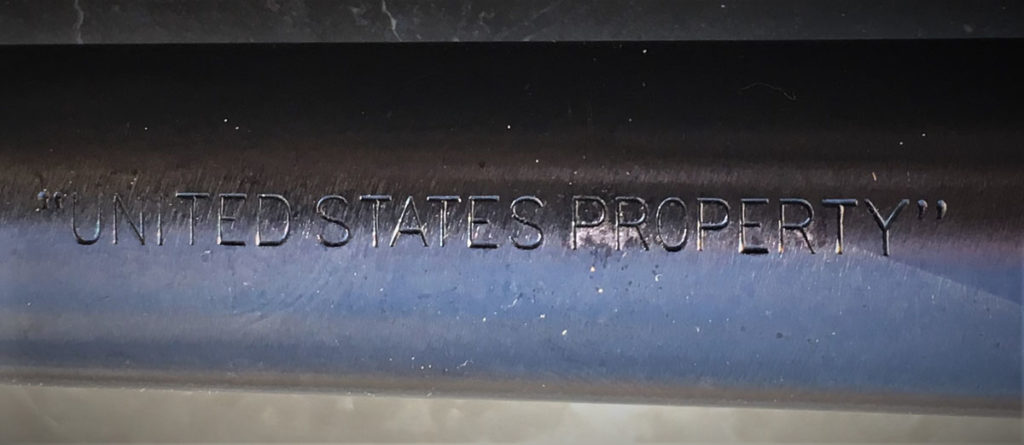
If you were to be so inclined to want to keep one in your nightstand, you should have no problem coming up with some decent defensive ammo for a Colt 1917. However, given the age and availability of these old gals, I don’t think I would put one through the abuse of being a daily carry piece. I have no doubt the design is more than durable enough. But much like a P.08 Luger while it would be possible to use one for carry, there are some current production handguns that would fit the bill a little better while not putting the wear and tear on a valuable piece.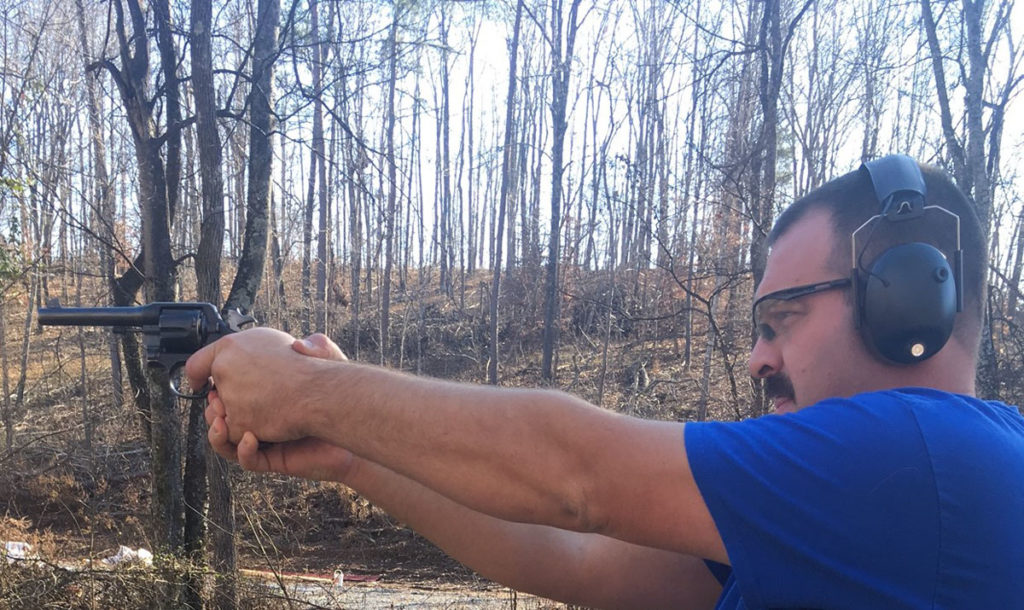
This particular Colt 1917 was produced in 1918, according to my research. It looks as though it was parkerized at one point. It has some nicks and dings like you would expect on an old service revolver. It was probably refinished again after being in private hands. But mechanically, it is solid. The cylinder is one of those that were properly chambered for .45 ACP.

Something interesting about Colt 1917 revolvers is the dual serial number. Prior to the US military orders, Colt placed the serial numbers on the New Service revolvers on the inside of the frame, in the cutout where the crane fits when the cylinder is closed, and on the crane itself. Uncle Sam wanted the serial number on the butt. So, the Colt 1917s ended up with both. There is a certain amount of debate as to which is the “real” serial number. Since it was a US Military issued weapon, I’m going to side with Uncle Sam on this one.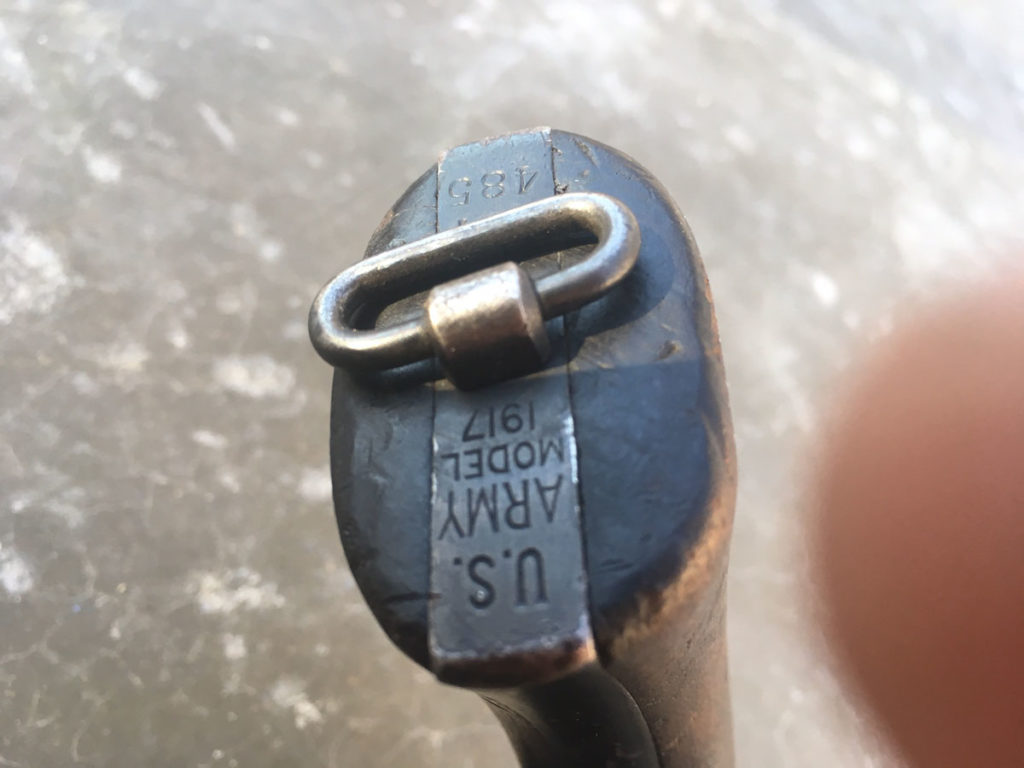
I decided to go about test-firing for this article a little differently than just your typical accuracy test. This revolver was intended to be a sidearm for troops going “over the top”. Sidearms saw a lot of use during WWI. So, I thought it appropriate to shoot it in more of a combat-related manor, rather than just shoot groups for accuracy. The ammunition I used for the test fire were some 230gr reloads, which were loaded to mimic typical factory loads. For a target, I used a military “e-type” pistol target set at 25 yards. Since a lot of combat shooting would’ve been done in double-action, I did this as well.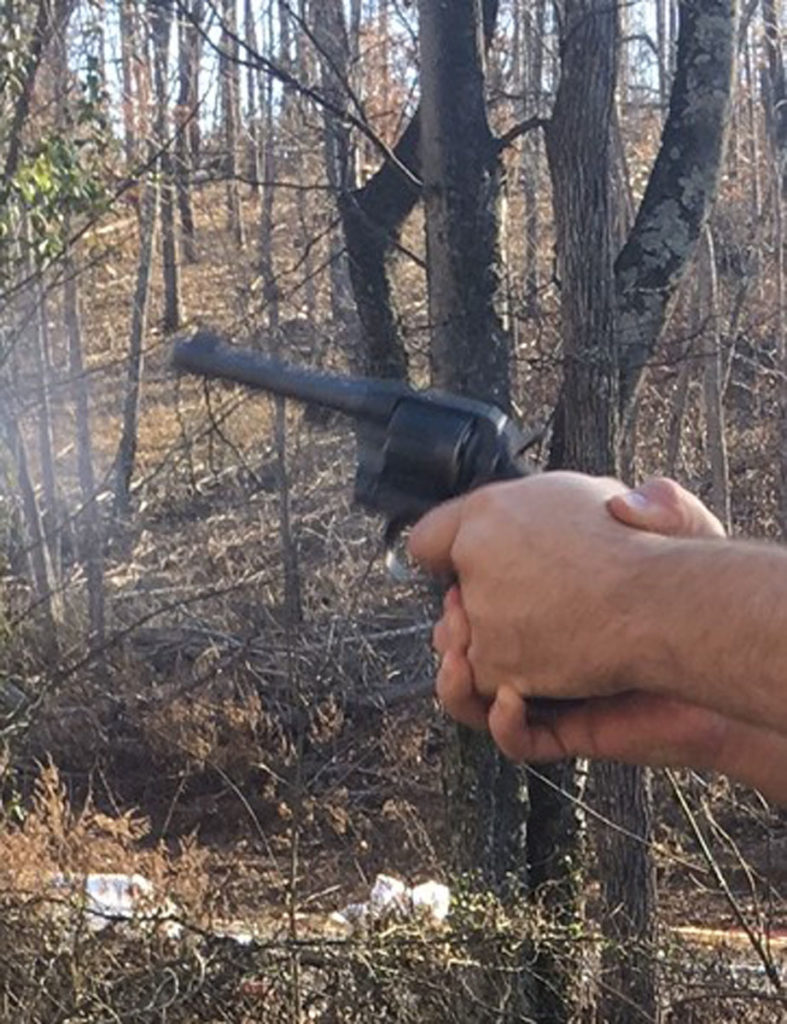
The single action trigger pull on this old colt was light and crisp. The double action pull was long and fairly heavy-about what you’d expect from a double action revolver. But I didn’t think it to be unmanageable like some other military revolvers I’ve owned. It probably slowed down my rate of fire somewhat. The weight of the all steel frame and barrel also reduced the recoil significantly. The sights leave a little something to be desired, but that was the norm for sidearms at that time. From a standing position, it was pretty easy to keep my rounds inside an “e-type” silhouette target at 25 yards. Altogether the Colt 1917 is a fairly pleasant gun to shoot.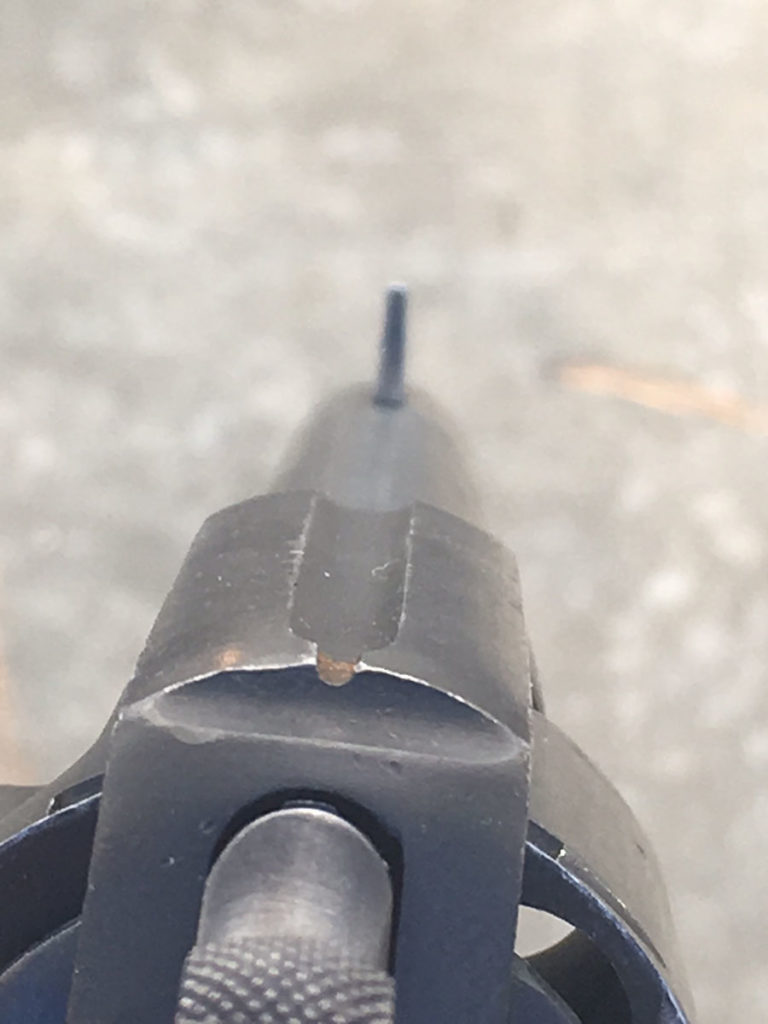
Reloading is pretty fast for a revolver, courtesy of the three-round clips, though I was still considerably slower than with an Auto pistol. Be aware that the clips can and will bend over time. This can cause the cylinder to “hang-up” when it’s being close, or when it’s rotating during operation. You can flatten them back out when this happens. In military service, these were intended to be expended with the empty cases. Obviously, we as shooters do not consider them to be that expendable. But they will wear out eventually. Fortunately, they are not particularly expensive. I did try shooting without the clips, just to see how hard it would be to extract the cases. After firing, I was able to pluck the cases out with just my fingers, and it wasn’t at all difficult.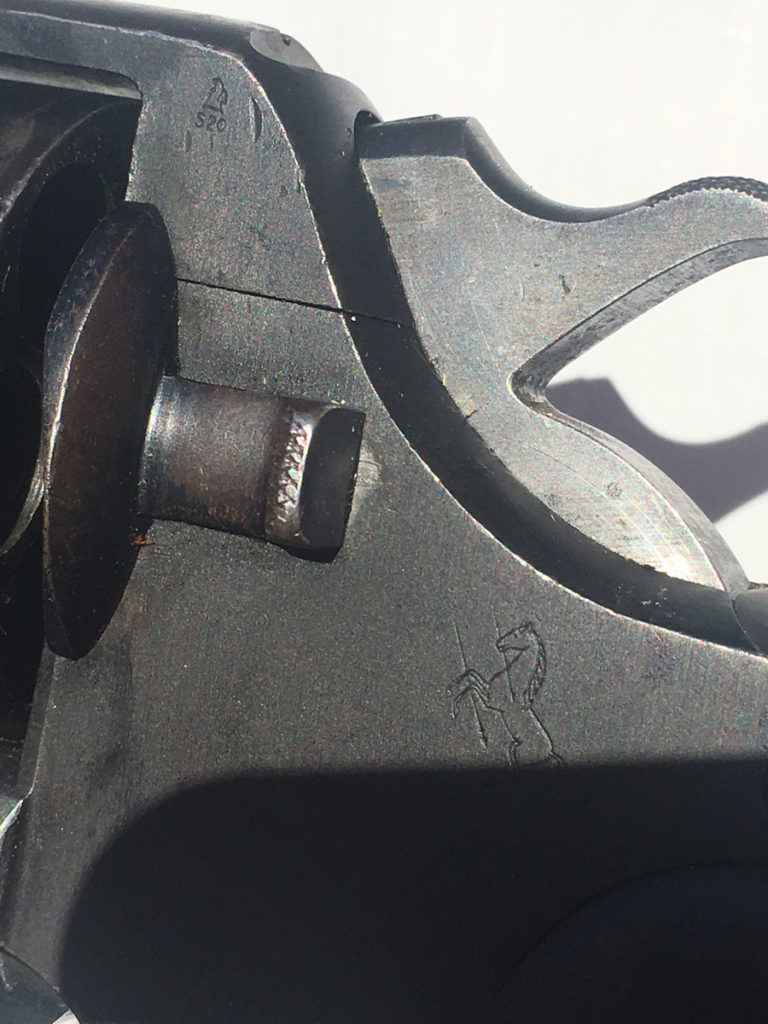
Overall the Colt 1917 is a very interesting revolver. It was a stop-gap sidearm that ended up with American troops in two world wars. 1917 revolvers, both Colt and Smith & Wesson, can usually be found for reasonable amounts of money (especially in comparison to other US military revolvers, or WWI 1911s). They are not difficult to find suitable ammunition for, and they’re strong enough to enjoy some range time with. So if you’re looking for a WWI handgun to add to your collection, consider one of these old Colts.

Can’t figure what it fires look like. 32 or .38
Can anyone help?
Can’t figure what it fires. What is it
I was an Infantry officer with the 1st Cav in VN. I carried a Colt 1917 as my personal handgun and used it during fire fights. It remains my prized possession to this day.
I would like to know when Colt started making 44 revolver or did they have to be converted to 44 from 32-40?
Recently picked up a Charter Arms “Pitbull” – small frame, (5) shot revolver designed specifically to fire the .45acp cartridge. They also offer versions in .40S&W and 9mm. These revolvers have a unique cylinder which has spring-loaded “tabs” in each chamber that function as retainers for each round when inserted. Very unique design and thus far I’m both impressed and satisfied. The true test will be in the longevity of the system, but these are intended to be carried a lot and fired little. They also carry a lifetime warranty that follows the gun, not just the original purchaser/owner.
Bought a 1917 on line and love the gun.Someone had hand checkered the grips and not done a very good job so I found originals on the internet.Also bought a original lanyard and holster.Gun shoots beautifully to point of aim.If you run out of ammo it would make a hell of a club.
A friend of mine, that is now, deceased, had an old double action Colt. It was parkerized and had a lanyard ring at the base of the grip frame. It sported a six-inch barrel, six shot cylinder, and was chambered for the .45 Long Colt cartridge. Due to the barrel length and chambering, the revolver was rather large. It came with fixed v-rear sights and a tall blade front sight. The front sight could have been bent for windage and filed for elevation adjustment. The one thing that stood out was how strong and well built the revolver, was. As for its weight,well, I would not have wanted to carry it into combat.
Since I’m only using mine on a range, I have no need for moon or half moon clips. There is a moon clip available now that I believe is nylon and therefore easier to extract casings from. I suspect the original idea of the spring steel clips was, like the Garand enblocs, to discard them.
I have a S&W Canadian contract WWI that was originally chambered for 455, but later bored to 45 Colt. I also have a 1917 S&W, and a 1937 Brazilian contract S&W chambered in 45acp. I like to load 45 auto rim for the 45 acp’s, but I keep the loads down to around 700 fps with a 250 grain cast bullet. Fun to shoot, and safe in the old wheel guns.
veddie inderesting
Great article, thank you!
I do wish we could have seen some of the groups that the old warrior can shoot…?
Thanks for the article; I love the WWI and II firearms features.
Keep up the good work, please.
First off for the guy that wondered about the 9mm as it would fit in his 38sp, I won’t run upstairs and check, but if I remember correctly the 9 will not fit in the 38. Now I use to think it would until I tried it. Anyway, I have the S&W in 45acp, and it is a wonderful firearm. Now I would have The Colt Army in 45acp but an internet seller called Gun Runners made a huge mistake in their listing. Now I would buy from them again, but their policy is No Returns even if they made a mistake. The story in short, I won a Colt 1917 Army in 45acp. When I got the gun I knew something was young as 45acp would not work With some research I found that I had a 1907 Colt Army in 45 Colt or Long Colt if you want. Well Gun Runner would not allow a return, and I said that was fine as I was not going to return it anyway as the 1907 is worth about $500 more then the 1917. Both are fun Revolvers, but do not go hot in them. If you want a Bear Gun get a Redhawk in 45 Colt / 45acp, yes it weighs like 43 oz of so, but it is a wonderful modern version that will shot an hot load made by any major manufacture.
A former Sheriff friend of mine had a beautiful 45 ACP US military revolver with the original finish turned green over the years. I fell in love with large frame revolver right on the spot. I’ve always had a thing for P14 Enfields( Springfields) too! Both are rapidly going out of my price range – so I’ll just dream on.
I am wondering if this weapon will fire .45 Long Colt rounds as well? Perhaps the cylinder is too short? Seems to me that the revolver bullets were longer than the automatic version.
It depends which model you run into – the .45 ACP version does have the cylinders bored for that cartridge only, so they won’t fall through the cylinder. As the article explains, you had to have that for the firing pin to work.
Depends on the particular gun. I have 3 Colts and 1 S&W. 1 of the Colts fire 45 long colt only, one fires 45acp with clips and 45 long colt, 1 fires only 45acp. The S&W fires 45 acp only.
I bought a Ruger New model Blackhawk in stainless 45 LC the first thing I did was send it back to Ruger and get it fitted with a 45ACP cylinder. Works great!
I’ve a repro. of the Smith 1917 , and enjoy it ! Left to me by my late Father , and keep it
bedside . Full moon clips are “speed loaders” , true . But , that APC round will get the job done if needed .
Always been a “wheel gun ” man , and the weight and feel suits me down to the ground !
I’ve wondered for some time now if anyone has done the same thing with the 9mm since the cartridge fits my 38?
I have a 9mm cylinder for my Ruger Blackhawk .38/.357. Ruger made them.
I don’t think the 9mm fits your 38, but I have not checked this for a long time. Seems it will not fit, but you can get the cylinder modified so it will shot both 9 and 38. I own a few 9mm revolvers, and they are nice shooters.
S&W made if I recall correctly a Model 547 revolver in 9mm and the current 929 in 9mm. S&W won a contract with the French police years back for a 9mm revolver. The new 929 uses clips holding 8 rounds. The 547 and French guns did not use clips and had an extractor which engaged under the rims of the 9mm cartridge case.
I picked up a copy of the S&W version a few years back for a song. Well, not literally, but still, the price was 3 digits, the first being a “1”. The finish is a worn blue, but the lockup is tight and that 100 year old revolver still shoots just fine.
Thanks for a good article. I own a Colt Model 1917 that still goes to the range.
No, the 1911 was carried in 2 world wars, Korea, Vietnam, Just Cause, Desert Shield and Storm…
My father carried the S&W version as an infantry officer in the Korean war. I bulged the cylinder in the 1970’s and sent it off to Smith for new cylinder, barrel, and reblueing. Beautiful, shootable coffee table gun.